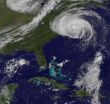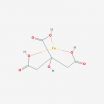MIT moves toward greener chemistry
Breaking up phosphorus with ultraviolet light may offer a safer, simpler way to build many industrial and household chemicals
2010-09-04
(Press-News.org) CAMBRIDGE, Mass. - Phosphorus, a mineral element found in rocks and bone, is a critical ingredient in fertilizers, pesticides, detergents and other industrial and household chemicals. Once phosphorus is mined from rocks, getting it into these products is hazardous and expensive, and chemists have been trying to streamline the process for decades.
MIT chemistry professor Christopher Cummins and one of his graduate students, Daniel Tofan, have developed a new way to attach phosphorus to organic compounds by first splitting the phosphorus with ultraviolet light. Their method, described in the Aug. 26 online edition of Angewandte Chemie, eliminates the need for chlorine, which is usually required for such reactions and poses health risks to workers handling the chemicals.
While the new reaction cannot produce the quantities needed for large-scale production of phosphorus compounds, it opens the door to a new field of research that could lead to such industrial applications, says Bertrand, who was not involved in the research.
Extracting phosphorus
Most natural phosphorus deposits come from fossilized animal skeletons, which are especially abundant in dried-up seabeds. Those phosphorus deposits exist as phosphate rock, which usually includes impurities such as calcium and other metals that must be removed.
Purifying the rock produces white phosphorus, a molecule containing four phosphorus atoms. White phosphorous is tetrahedral, meaning it resembles a four-cornered pyramid in which each corner atom is bound to the other three. Known as P4, white phosphorus is the most stable form of molecular phosphorus. (There are also several polymeric forms, the most common of which are black and red phosphorus, which consist of long chains of broken phosphorus tetrahedrons.)
For most industrial uses, phosphorus has to be attached one atom at a time, so single atoms must be detached from the P4 molecule. This is usually done in two steps. First, three of the atoms in P4 are replaced with chlorine, resulting in PCl3 — a phosphorus atom bound to three chlorine atoms.
Those chlorine atoms are then displaced by organic (carbon-containing) molecules, creating a wide variety of organophosphorus compounds such as those found in pesticides. However, this procedure is both wasteful and dangerous — chlorine gas was used as a chemical weapon during World War I — so chemists have been trying to find new ways to bind phosphorus to organic compounds without using chlorine.
A new reaction
Cummins has long been fascinated with phosphorus, in part because of its unusual tetrahedral P4 formation. Phosphorus is in the same column of the periodic table as nitrogen, whose most stable form is N2, so chemists expected that phosphorus might form a stable P2 structure. However, that is not the case.
For the past few years, Cummins' research group has been looking for ways to break P4 into P2 in hopes of attaching the smaller phosphorus molecule to organic compounds. In the new study, Cummins drew inspiration from a long overlooked paper, published in 1937, which demonstrated that P4 could be broken into two molecules of P2 with ultraviolet light. In that older study, P2 then polymerized into red posphorus.
Cummins decided to see what would happen if he broke apart P4 with UV light in the presence of organic molecules that have an unsaturated carbon-carbon bond (meaning those carbon atoms are able to grab onto other atoms and form new bonds). After 12 hours of UV exposure, he found that a compound called a tetra-organo diphosphane had formed, which includes two atoms of phosphorus attached to two molecules of the organic compound.
This suggests, but does not conclusively prove, that P2 forms and then immediately bonds to the organic molecule. In future studies, Cummins hopes to directly observe the P2 molecule, if it is indeed present.
Cummins also plans to investigate what other organophosphorus compounds can be synthesized with ultraviolet light, including metallic compounds. He has already created a nickel-containing organophosphorus molecule, which could have applications in electronics.
INFORMATION:
Source: "Photochemical Incorporation of Diphosphorus Units into Organic Molecules" by Daniel Tofan and Christopher C. Cummins. Angewandte Chemie, 26 August, 2010.
ELSE PRESS RELEASES FROM THIS DATE:
2010-09-04
PHILADELPHIA –- An international collaboration led by a University of Pennsylvania anthropologist has shown that environmental factors, like temperature and light, play as much of a role in the activity of traditionally nocturnal monkeys as the circadian rhythm that regulates periods of sleep and wakefulness.
The study also indicates that when the senses relay information on these environmental factors, it can influence daily activity and, in the case of a particular monkey species, may have even produced evolutionary change. It is possible, according to the study results, ...
2010-09-04
NASA satellite data has noticed that Tropical Storm Fiona is getting "longer." That is, the storm is elongating in almost a north-south direction, indicating that she's weakening and may not make it through the weekend. Meanwhile, forecasters are watching two other areas for development in the eastern Atlantic this weekend.
The Geostationary Operational Environmental Satellite, GOES-13 captured an image of Fiona on Friday, Sept. 3 at 10:32 a.m. EDT and the visible image showed a weak circulation in Fiona's center. It also appeared that Fiona's clouds were "stretched" ...
2010-09-04
NASA satellites and the International Space Station are keeping eyes on Hurricane Earl as it heads for New England. Watches and Warnings are posted in the U.S. northeast.
Having felt the effects of both increasing wind shear and cooler waters, Hurricane Earl weakened to a Category 2 storm on the Saffir-Simpson scale with winds still powerful at 90 knots (104 mph) as it neared the North Carolina coast. It was at this time that the Tropical Rainfall Measuring Mission (TRMM) satellite captured the data about TRMM's rainfall rates.
The rainfall pattern associated with ...
2010-09-04
MBL, WOODS HOLE, MA—One of the big, unsolved problems in explaining how life arose on Earth is a chicken-and-egg paradox: How could the basic biochemicals—such as amino acids and nucleotides—have arisen before the biological catalysts (proteins or ribozymes) existed to carry out their formation?
In a paper appearing in the current issue of The Biological Bulletin, scientists propose that a third type of catalyst could have jumpstarted metabolism and life itself, deep in hydrothermal ocean vents.
According to the scientists' model, which is experimentally testable, molecular ...
2010-09-04
SAN ANTONIO, TX (Sept. 3) — A long-term study of women with a genetic predisposition for breast or ovarian cancer showed that those who elected major preventive surgeries had a significantly reduced risk of those cancers.
The study, published Sept. 1 in the Journal of the American Medical Association, confirms the view of one of its researchers, Gail Tomlinson, M.D., Ph.D., interim director of the Greehey Children's Cancer Research Institute at The University of Texas Health Science Center at San Antonio.
Dr. Tomlinson said that for women with certain genetic mutations, ...
2010-09-04
Something has been eating Charlie Kerfoot's doughnut, and all fingers point to a European mollusk about the size of a fat lima bean.
No one knew about the doughnut in southern Lake Michigan, much less the mollusk, until Michigan Technological University biologist W. Charles Kerfoot and his research team first saw it in 1998. That's because scientists have always been wary of launching their research vessels on any of the shipwreck-studded Great Lakes in winter. But NASA's new Sea-viewing Wide Field-of-view Sensor (SeaWiFS) Project was giving scientists a safer way to ...
2010-09-04
Summer is winding down, and Dr. Eric Mariotti (www.drmariotti.com) is now seeing an increase in consultation requests at his Walnut Creek area plastic surgery practice. With kids heading back to school, parents are finding that their schedules are freeing up and many are making more time for their cosmetic goals.
"As a father myself, I understand how busy summers can get for parents," states Dr. Eric Mariotti. "Between watching the kids and working, it can be pretty hard to find time for yourself in the summer months. Early fall is when a lot of people start thinking ...
2010-09-04
As the year end deadline looms for President Obama's American Recovery and Reinvestment Act of 2009, Galaxie Home Remodeling wants every Chicago Area Homeowner to take advantage of this Federal Tax Credit before it expires. As a further incentive to the federal tax credit, Galaxie is now offering free installation on it's replacement windows. The federal program says that qualifying 'Energy saving" purchases made before the end of this year, are eligible for a 30% credit off of the purchase price, up to $1,500.
Galaxie, a full-service home remodeling serving the Greater ...
2010-09-04
American Wave Machines, Inc. (AWM), an innovator in artificial wave technology, today announced that for the first time surfboards with fins have been ridden in a surf machine that includes a barreling standing wave. The machine debuted at the Himlabadet Municipal Aquatic Sports and Spa Facility in Sundsvall, Sweden. The machine is another first for AWM and the locals in Sundsvall turned out in force to ride SurfStream at the opening day event sponsored by Quiksilver and Red Bull.
The event was a successful live demonstration of the newly patented barreling wave technology ...
2010-09-04
Recently HomeschoolBlogger.com (HSB)—the largest and free homeschool blog site in the world—got a clean, fresh, new look with an exciting combination of new features, as a result of implementing an important software upgrade.
According to The Old Schoolhouse Magazine publisher/owner Gena Suarez, "The plan behind the change is to tie great blogging in with the ever-expanding homeschool community to usher back in the 'blogging craze' that hit when HomeschoolBlogger was launched in 2005. It was a lot of work, we pushed forward, and now we're doing it. This is a major upgrade, ...
LAST 30 PRESS RELEASES:
[Press-News.org] MIT moves toward greener chemistry
Breaking up phosphorus with ultraviolet light may offer a safer, simpler way to build many industrial and household chemicals



